This incredible Vietnamese cafe building is like a giant chocolate box
My first impression of Ho Chi Minh City’s famed Cafe Apartments, a nine-storey, Rubik’s Cube-like block known for its proliferation of kitsch coffee houses and shops, is, shall we say … underwhelming. A bookstore, modern and sterile, fills the bottom two floors of the complex. After some dithering I finally find the apartment entrance, a nondescript (at least for non-Vietnamese speakers) shabby concrete ramp and passageway tucked to the left of the building, leading to a stairway and elevator guarded by an insouciant warden, charging 3000 dong (about 20c) a ride.
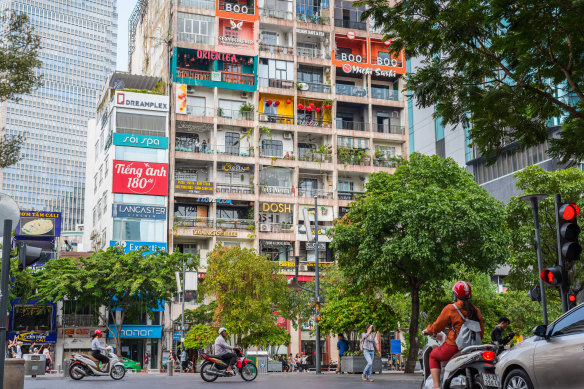
The Cafe Apartments have become a Ho Chi Minh City cultural phenomenon in recent years.Credit: iStock
But it’s soon clear there’s beauty and charm to be found in this seemingly unremarkable structure. Wandering (and caffeinating within) its curious passageways, lined with fashion boutiques, retail shops and yes, myriad cafes, you can easily lose a day. Cold brews, cream-topped iced matchas, vinyl records, banh mi, doughnuts, clothes – no shortage of reasons to climb up, and up.
At nine storeys, the boxy building was once the tallest in then-Saigon. Constructed in the 1960s as dormitories for French and American military personnel, today the building straddles a line between eyesore and modernist treasure. When the South lost the war, the government reclaimed the block for its northerners. When they moved on, the flats were rented to cafes and businesses, but the apartments’ coffee moniker is new – barely a decade old, supposedly coined by a National Geographic journalist. The name not only stuck, but became a beacon for a new crop of hospitality venues, catapulting the site into something of a Ho Chi Minh City cultural phenomenon; savvy photographers and Instagrammers covet its Wes Anderson-like aesthetic.
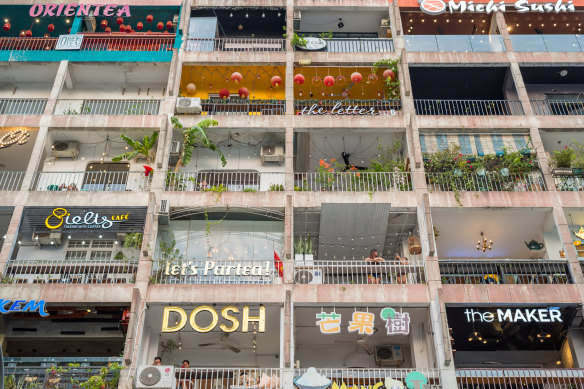
Wes Anderson, eat your heart out.Credit: iStock
The building, with its boxy facade, is at its most photogenic from a distance – a chocolate box of eclectically styled cafes, tea houses, restaurants and co-working spaces. After dark, it fizzes with the blazing-neon energy of Tokyo – each stacked cube vying for attention with coloured lanterns, disco balls, strings of bunting, big dangling bulbs and potted greenery spilling over identical balconies. Some venues moonlight as bars. Beyond its quirky exterior, to quote one Tripadvisor reviewer, the block “needs a good clean”. But there is appeal in its unapologetic state; its corroded form betraying decades of hardship, diverse inhabitants and reinvention.
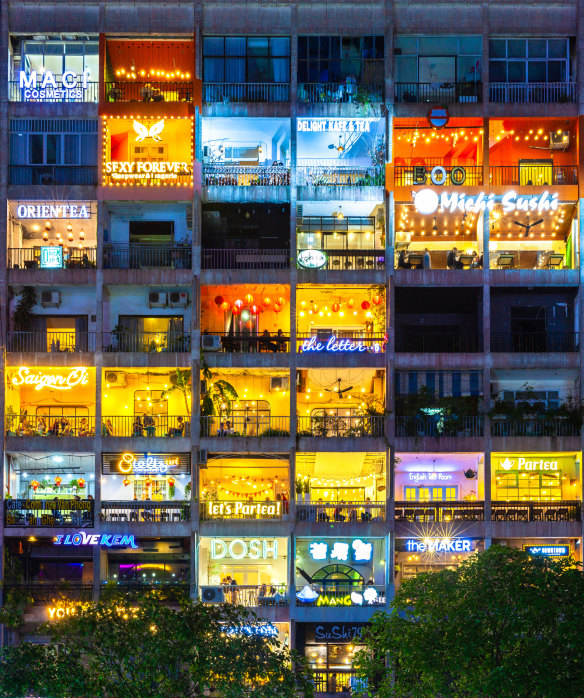
Chocolate-box facade: the cubes come to life after dark.Credit: iStock
Where better to learn about Vietnamese coffee? I’ve already spent some time exploring the city’s specialty cafes – as good as any hipster spots in Sydney or Melbourne (and nearly as pricey).
Globally, Vietnamese coffee’s reputation precedes it, owing to that most glorious and sinful of combinations; strong robusta coffee with sweetened condensed milk. Served over ice and delivering a dual thwack of bitter and sweet, caffeine and sugar.
But what we broadly dub “Vietnamese coffee” – an invention of the South – is just one of a throng of regional specialties.
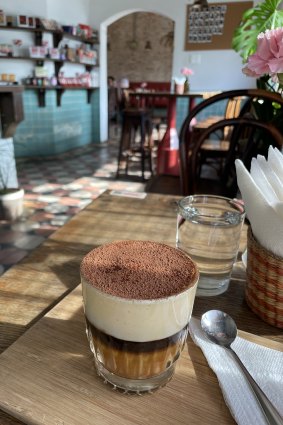
Specialty coffee house Okkio Le Loi is renowned for its egg coffee.Credit: Katherine Scott
“When you try egg coffee, you will see it clearly; North and South Vietnam,” says 35-year-old Quynh Tran, founder and host of “Vietnam Coffee Journey: What Locals Drink”, a coffee masterclass based out of his private coffee lab on the building’s ninth floor. The man knows his beans, having previously run The Workshop, one of the city’s leading specialty coffee venues.
Egg coffee, invented in the former French-occupied North, soared to prominence internationally amid pandemic TikTok mania; its devotees seduced by its creamy texture and fetching look. For the poorer working class in the South, the better-known ca phe sua da (iced coffee with condensed milk) was the original energy drink.
“Why did it become the icon of coffee in Vietnam?” Quynh asks, before answering himself. “South Vietnam lost the war; those who fled took their coffee to the world.”
Our coffee-curious band of four are huddled around a table on Quynh’s enclosed (but air-conditioned) balcony sipping icy coconut coffees – a heavenly blend of drip coffee, condensed milk, coconut cream and ice, though some variations use coconut sorbet (a revelation). Views from the balcony stretch across the promenade, trailing up to the ornate peach-hued Paul Gardes-designed City Hall building, a reminder of its French colonial past. The city, like its coffee, wears its chequered history on its sleeve.
Vietnam’s coffee evolution traces a turbulent timeline: the arrival of French colonies in the 1900s sprouting the first bean plantations; the introduction of condensed milk in the South by way of American soldiers; the Communist Party’s cessation of Western trade in 1975, causing annual coffee production to plummet – 80,000 metric tons to 18,000, almost overnight.
The industry’s decline continued until the 1986 Doi Moi economic reforms, which saw the nation switch gears again. “At that time there was coffee fever – if you wanted money, you moved to the highlands and produced coffee,” says Quynh, as we sip some pre-prepared cold brew, which I tactically vow not to finish, despite its agreeably delicate flavour.
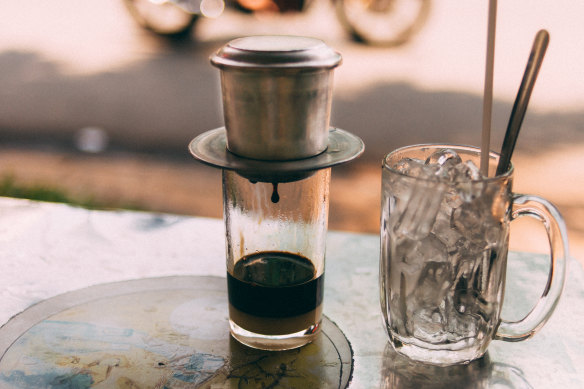
Phin drip coffee requires patience.Credit: iStock
Quynh continues, explaining how it was little surprise farmers preferred the resilient and higher yield robusta coffee plants to the fussy (but higher quality) arabica. Within five years, Vietnam was the world’s third-biggest coffee exporter. Today, it’s second, behind Brazil, which produces about 70 per cent of the world’s arabica supply.
Vietnam’s coffee obsession has reached new heights domestically, too; demand for its novelty offshoots – salt coffee, yoghurt coffee, egg coffee, smoothie coffee – is huge, and adds to a burgeoning third-wave movement of pour overs, Chemex, syphon, Aeropress and cold drip.
At this point, Quynh slides a traditional metal drip filter (phin) in front of each of us. There’s a lazy way of making drip coffee and “the Vietnamese way”; he shows us both. The latter involves pouring just enough boiling water in the chamber to soak the grounds, leaving the granules to bloom over several minutes before adding the remaining water and letting the drip mechanism to do its thing. It’s an exercise in patience, but the payoff is astonishing – skip this step and you get a whiplashingly bitter brew.
It’s an approach both North and South can agree on, at least. In fact, Hanoians even have a slogan that roughly translates to “in Hanoi, don’t hurry”. This ethos certainly applied when Nguyen Van Giang, a barista at the Sofitel Legend Metropole Hotel in Hanoi, invented egg coffee in 1946. He wanted to share this posh French style of coffee with his community and, in the face of a milk shortage, he whisked in egg yolk as a substitute to achieve the same creamy consistency.
We give it a go; brown sugar, Himalayan pink salt and egg yolks go into steel cocktail shaker. Using a hand mixer with one beater, we whisk the ingredients, while dipping the shaker in a scalding pot of water. The heat pasteurises the egg as it whips into a rich, velvety yellow foam. It takes around three minutes to get the desired consistency, before we assemble and give it a final dusting of chocolate powder. It’s thick, creamy and not too eggy.
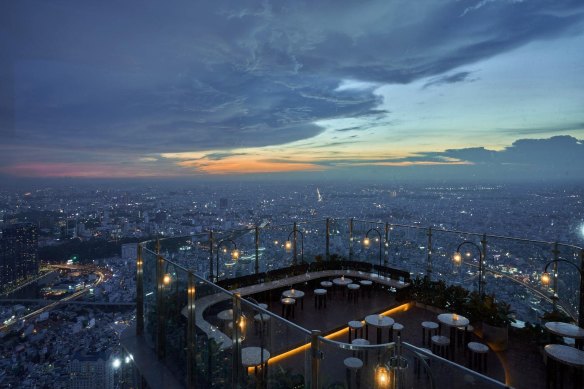
Sky-high buzz: Blank Sky Lounge on level 75-76 of the Landmark 81 high-rise.
Quynh’s demonstration concludes on a lighter note, with coffee “tea” made with by-products of the extraction process; dried cherry skins and pulp, called cascara. This brew is light, wonderfully fruity and, crucially, much lower in caffeine.
Later that evening, still buzzing, I venture to Ho Chi Minh City’s tallest skyscraper – the 461-metre-high Landmark 81, also home to the city’s highest terrace bar, Blank Sky Lounge. I’ve no idea why it’s called that – drinks take cues from the country’s rich heritage. It’s unsurprising to find coffee cocktails stand out among the signatures.
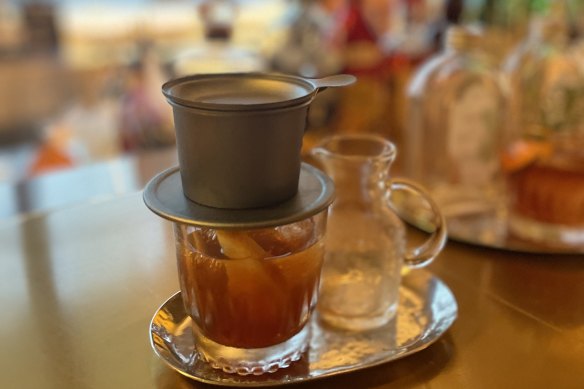
The Phin-tini, inspired by Ho Chi Minh City’s coffee culture.Credit: Katherine Scott
My eyes are drawn to a familiar contraption on the bar; a trendy grey, matte phin drips a red-tinged liquid over a rocks glass with an orange wedge. I take a sip; the Phin-tini is an intoxicating wash of coffee, Aperol, gin, orange and menthe-pastille (clear mint liqueur). Is that dizzying feeling the caffeine, sugar, or startling views from the 75th-floor glass-hemmed terrace? The sun sinks further, and the gritty metropolis below sparkles to life in gentle waves.
When I return to the bar, it’s the egg coffee martini – topped with a singed “brulee” egg cream – that calls to me. But my heart quickens at the mere thought; yep, I’ve hit my limit.
THE DETAILS
Fly
Jetstar flies between Ho Chi Minh City and Melbourne four times a week, and Sydney three times a week. It’s the only Australian carrier operating direct flights between Australia and Vietnam. See jetstar.com.au
Tour
Vietnam Coffee Journey – What Locals Drink runs for 2.5 hours and includes five coffee-based drinks from $36. Bookings through Airbnb Experiences. See airbnb.com.au
Half-Day Local Breakfast Tour in Ho Chi Minh (by Saigon Happy Tour) takes guests on a motorbike food tour to sample 7-8 classic breakfast dishes and traditional coffee, including Ho Chi Minh City’s oldest coffee business in Phung Hung Market. Bookings through Expedia Activities. From $59 a person. See expedia.com.au
Stay
Silverland Yen Hotel, Ho Chi Minh City is centrally located in District 1. Rooms from $183 a night, including Wi-Fi and select minibar items. See silverlandhotels.com
Six spots in Ho Chi Minh City for a coffee fix
NEW WAVE
The Workshop Coffee
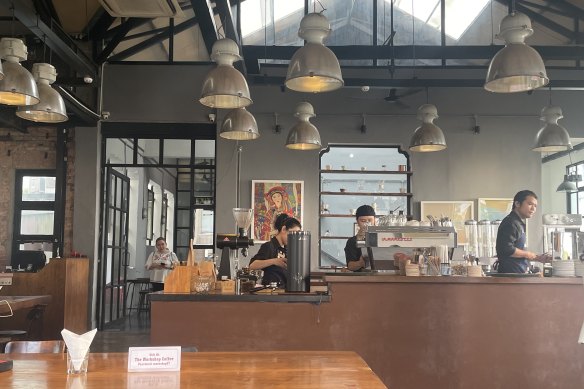
Saigon’s specialty coffee mecca … The Workshop Coffee.Credit: Katherine Scott
V60 pour overs and Chemex filters? Seemingly more Melbourne than Ho Chi Minh City, this industrial cafe is a stickler for specialty brews and artisanal beans. Grab your morning pick-me-up to go, or linger over a bowl of pasta. 27 Ngo Duc Ke, Ben Nghe, District 1. Phone: +84 28 3824 6801. See facebook.com/the.workshop.coffee
Okkio Caffe, Le Loi
This roaster and cafe chain is renowned for its egg coffees, but you’ll find all types of traditional and new-wave brews within the stylish, heritage open-bricked walls of its original Le Loi site. Follow the beautiful red spiral staircase to the top where a staggering drinks list awaits; cold brews, taro lattes, matcha coffees – they’ve got it all. 120 - 122 D. Le Loi, Ward Ben Thanh, District 1. Phone: +84 848 011 118. See okkiocaffe.com
Hummingbird Cafe and Roastery
Tucked off a major traffic artery Vo Thi Sau Street, this swish contemporary cafe with indoor and outdoor seating is an oasis of calm away from the blare of motorbikes. Unwind with a cold brew (beans are roasted onsite), and just try to resist that Earl Grey butter cake with orange jam and yuzu sorbet. 103BIS D. Vo Thi Sau, Ward 6, District 3. See thehummingbirdsaigon.com
TRADITIONAL
Ca Phe Do Phu (secret weapons bunker)
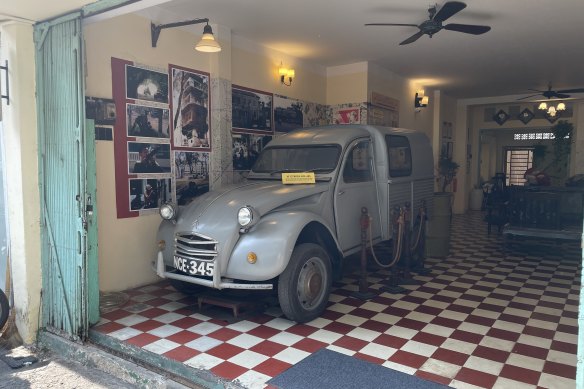
Ca Phe Do Phu: Coffee in a former Viet Cong secret weapons bunker.Credit: Katherine Scott
Part cafe, part living museum, Ca Phe Do Phu is easily one of Saigon’s most fascinating spots for a cuppa – its walls and floors hide a former secret Viet Cong war bunker, which once stored two tonnes of weaponry eventually used in the famous 1968 Tet Offensive (the vintage Citroen used to smuggle the weapons remains on display at the front). Buy a coffee to explore the museum and bunker for free. 70 Nguyen Dinh Chieu, Phuong 5, Quan 3.
Ca Phe Vot, Phan Dinh Phung
Hemmed in by motorbikes and customers (always a good sign), this well-priced and locally adored bolthole is where Saigonese go for their caffeine fix. Tucked down an alley on Phan Dinh Phun Street, you won’t find too many tourists at this third-generation cafe, so named for the fabric vot (fish) net used to make the traditional filter coffee. 330/2 Phan Dinh Phung, Phuong 1, Phu Nhuan.
Ba Lu Coffee, Phung Hung Market
The historic Phung Hung Market is home to one of the oldest coffee businesses in Ho Chi Minh City, Ba Lu Coffee – a gem if you can find it. Hung Co, son of the founder, roasts his beans weekly and filters the coffee into clay pots using the traditional fabric fish nets. It’s one of the delicious stops on Expedia’s Half-Day Local Breakfast Tour in Ho Chi Minh, from $59. 214 Phung Hung Street, Ward 14, District 5. See expedia.com.au.
The writer flew as guest of Jetstar; activities, tours and food were at the writer’s expense.
Sign up for the Traveller Deals newsletter
Get exclusive travel deals delivered straight to your inbox. Sign up now.